The Fatality Analysis Reporting System (FARS) is a query-driven database where all vehicle crashes in the United States as recent as 2014 are provided for public access. Vehicle crash fatalities are able to be filtered by a number of different options depending on the thoroughness of crash reporting. The filtered options can then be univariate or cross-tabulated for comparing data. It is important to note that the traffic volume and roadway length are not provided in the FARS database and that full crash rates cannot be calculated or analyzed because the exposure factor cannot be assessed. It is also noteworthy that the FARS data only give information regarding light condition and do not consider visibility treatments associated with retroreflectivity.
These data were considered in the three areas of roadway departure, intersection, and pedestrian and bicycle safety. The data, however, are not consistent across the areas. These differences are summarized below. Additionally, other variables were considered in this analysis and are also listed below.
Safety Data Considered
Roadway Departure
A crash is considered a roadway departure crash when a vehicle leaves the travel lane or lanes by either crossing the shoulder line or the center line of a roadway. It is important to note that the FARS database is not confident in the detailed reports of pedestrian and bicyclist data, including whether the pedestrian/bicyclist was on or adjacent to the roadway when struck, which would also inform roadway departure crashes.
Intersections
Intersections are areas of high conflict, and crashes at intersections can be attributed to a number of different causes. When considering pedestrians and bicyclists at intersections, similar to roadway departure crashes, the details for conflicts involving pedestrian and bicyclist crashes are not included in the FARS database.
Pedestrians/Bicyclists
There is a lack of data regarding conflicts with vehicles and pedestrian/bicyclist fatalities. The FARS database does have a disclaimer that inconsistencies were identified in the pedestrian and bicyclist data. Thus, while some of the data are used for this analysis and the absolute numbers of fatalities provided in the database are said to be accurate, further qualifiers such as motorist, pedestrian, and bicyclist position and maneuvers are not included.
Other Data Variables Considered
Light Condition
In an attempt to find gaps in the research surrounding lighting, the three light conditions made available in the FARS database were used for this research: daylight; dark, not lighted; and dark, lighted. The dark, not lighted and dark, lighted conditions both encompass nighttime driving scenarios; however, one includes artificial infrastructure lighting. Daylight is simply defined by when natural light is present and is not otherwise considered dawn or dusk. Dawn and dusk were not included in this research because it is believed that the reporting of these times of day are objective and apt to be misattributed.
Weather
Weather can impact several factors in a typical driving scenario, not limited to traction or visibility. The conditions predominantly considered were clear (as a baseline), rain, and fog/smog/smoke. Rain is an extremely common weather type and is encountered regularly by most drivers. Snow, sleet, and hail were not as focused in this effort due to the available crash statistics and the variance not accounted for. Snow can be on the roadway or be recently cleared and on the shoulder and still be considered a snowy condition. While snow, sleet, and hail do have an impact on lighting, it is believed to not be far from the effects of rain in general. Fog/smoke/smog are represented well in the FARS database, and these conditions have a very direct and noticeable impact on lighting.
Driver Age
Driver age is an important factor due to the levels of experience, cognitive factors, and visual ability. Younger drivers are perceived to be more risk taking and more inclined to speed, whereas older drivers are believed to have trouble navigating complex segments and intersections and react more slowly to weather or other traffic.
Speed
One of the variables believed to strongly impact all three focus areas is speeding. One-third of all fatalities are reported to be a result of speeding, so speed is seen as a significant threat to safety. Aside from lighting technology that can serve as delineators or overhead roadway smart lighting that can adapt to driver speed and perhaps encourage drivers to slow down, there are few applications in infrastructure design where lighting can serve to curb speeding behaviors. On the other hand, the use of retroreflective infrastructure such as markings, signing, and delineation has some potential to control speed. For instance, peripheral transverse markings have been shown to be a successful countermeasure to speed, particularly in advance of a horizontal curve.(31)
Rural and Urban
Not only do rural and urban roadways naturally distinguish themselves by the purposes they serve, the driver behavior on each may also be considered different. In general, rural roads are higher speed, are less populated, and consume longer stretches. Typically, urban roadways are lower speed, are more traveled, contain more pedestrians and bicyclists, abut varying types of intersections, and are more commonly lit by overhead roadway lighting.
Roadway Departure Breakdowns
Roadway Departures by Rural and Urban by Weather
Clear conditions for 2014 account for nearly 7,000 fatalities on rural roadways and just over 4,500 for urban roadways. Shown in Figure 1, more crashes occur at night for both roadway types, with lighted areas consuming about half of all night crashes. Lighted areas are typically more complex areas or areas in which crashes are common or most likely. Due to this, results are somewhat skewed in their favor; however, data do not show that dark, unlighted areas may warrant lighting to curb the amount of crashes that take place. It is noteworthy that while there are some differences, most likely due to exposure (i.e., fewer rural roads have lighting) in general, the percentages of each of these lighting conditions are generally stable across all of the road types, and the percentages are also fairly evenly divided between the lighting conditions, even though there are typically much lower traffic volumes and exposure during the nighttime.
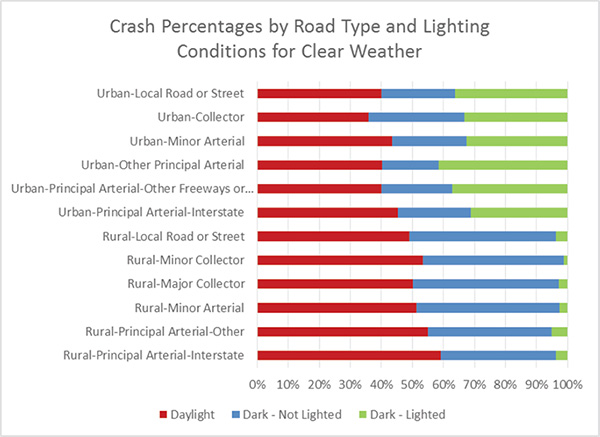
Figure 1. Crash percentages by road type and lighting conditions for clear weather. (FARS Database, 2014)
The rate of crashes in rain conditions is far less, with only 393 occurring on rural roadways and 270 on urban roadways (Figure 2). Despite the greater traffic on urban roadways, rural roadways account for more roadway departure fatalities for both clear and rainy conditions. This is likely due to the fact that less traffic allows drivers to increase their speed and higher speeds allow less opportunities for drivers to safely recover from a roadway departure, which tends to result in more severe crashes. Also, rural areas have much less access to timely emergency services, which increases the fatality rate. The other critical aspect is the change in the percentages for the dark, not lighted condition. While in clear conditions, the percentages were similar on many roadway types, the dark, not lighted condition has a higher percent contribution. This might indicate the importance of retroreflective performance and/or lighting in wet conditions in terms of roadway departure crashes.
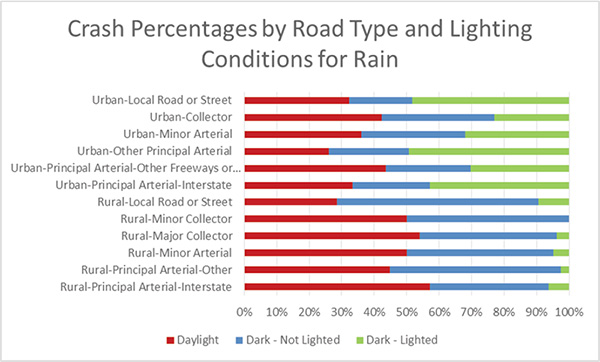
Figure 2. Crash percentages by road type and lighting conditions for rain. (FARS Database, 2014)
Weather Conditions and Roadway Departure
When conditions are clear or rainy, the rates of fatalities across lighting conditions are nearly identical. Figure 3 shows that larger differences exist during times of sleet, hail, snow, fog, and smoke. In general, sleet- or hail-related fatalities are very few, and only 13 total were reported in 2014 for rural and urban roadways combined. Snow-related fatalities occur more commonly in daylight or lit areas of urban roadways, again likely due to exposure. For rural areas, the link is more difficult to assess because snow presence/condition data are less available than they are for urban areas. Ideally, the snow presence/condition data would be more robust and include details on the difference between the presence of snow on a roadway and a scraped and salted roadway, which may not occur as often in some rural areas, and icy roadways as a result of all the above.
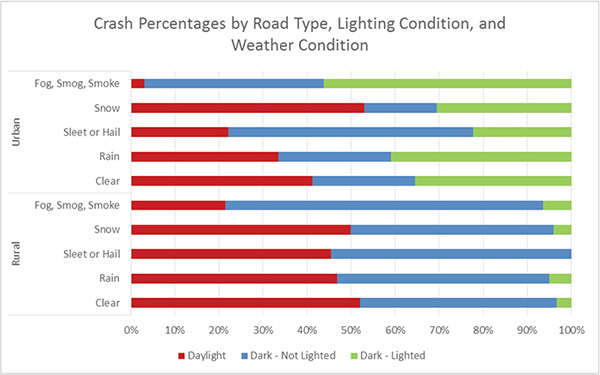
Figure 3. Crash percentages by road type, lighting condition, and weather condition. (FARS Database, 2014)
Age and Roadway Departure
Younger and middle-aged drivers perform similarly in clear and rainy conditions. Older drivers seem to have a higher daytime crash exposure than nighttime exposure. Again, older drivers tend to self-restrict their driving at night, so their exposure, particularly in the rain, is likely lower (Figure 4).
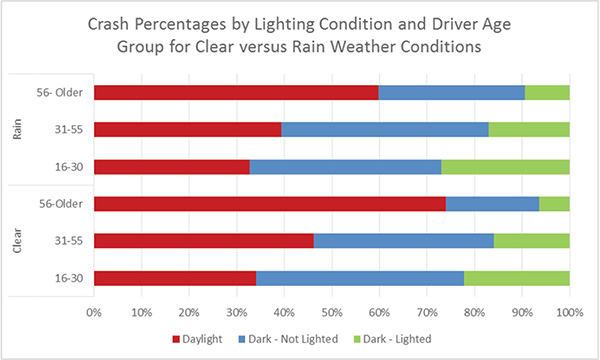
Figure 4. Crash percentages by lighting condition and age group for clear versus rain weather conditions.
(FARS Database, 2014)
Roadway Departure as a Result of Speeding
Because roadway departures are often linked to speeding, it is no surprise that more speeding-related roadway departure fatalities occur at night due to the fact that drivers often out-drive their headlamps. In other words, headlamps span between 250 to 300 ft ahead of the car, and at higher speeds, the reaction time this span creates becomes smaller. The increased number of speed-related fatalities shown in Figure 5 for lighted areas is interesting because it is believed that there are many more unlighted roads and thus more opportunity for roadway departure crashes. However, as already mentioned, lighted roadways are often lighted because the proclivity for crashes is predicted to be higher in those locations.
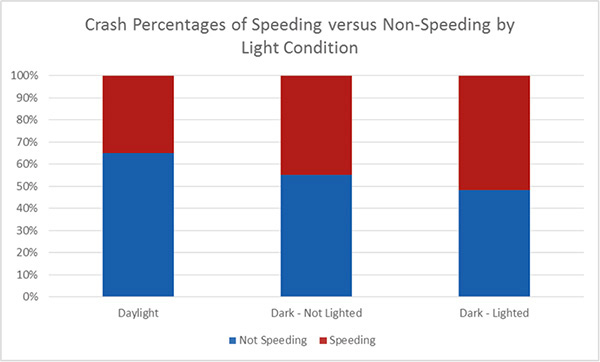
Figure 5. Crash percentages of speeding versus non-speeding by light condition. (FARS Database, 2014)
Intersection Breakdown
Intersection Fatalities by Light Conditions and Intersection Type
Figure 6 shows fatality crash totals for intersections. The percentages for intersections that are not four-way or T-intersections are perhaps too low for making statistical inferences, especially considering that roundabouts and five-point intersections are almost always lighted, so very few dark, not lighted fatalities will occur. The extent to which any of the intersections reflected in these data are lit is unknown. Despite some intersections being lighted already, there may be an opportunity to improve the lighting design. In many regards, the lighting of unique intersections, such as those with five or more points, may need to be considered case by case.
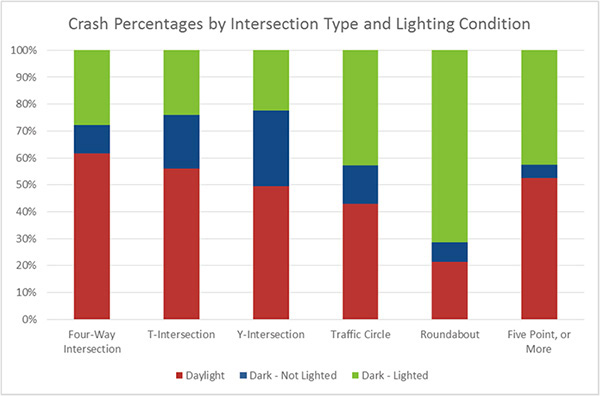
Figure 6. Crash percentages by intersection type and lighting condition. (FARS Database, 2014)
Fatalities at Four-Way Intersections by Age Group
Fatalities at four-way intersections are common among all age groups, with more older drivers being involved in fatal crashes during the daylight when they are likely more inclined to drive. Percentages in dark, unlit sections of road are consistent across all age groups, suggesting that unlit four-way intersections are less common and that age plays a small factor (Figure 7).
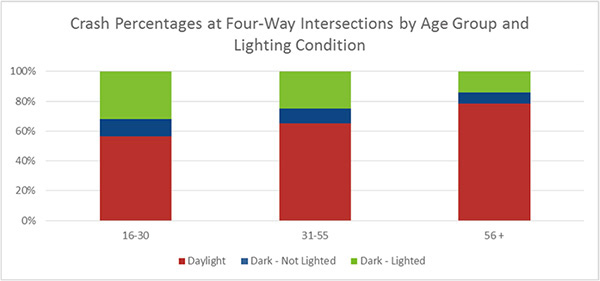
Figure 7. Crash percentages at four-way intersections by age group and lighting condition.
(FARS Database, 2014)
Figure 8 and Table 1 demonstrate the differences in traffic control type by lighting condition. The influence of these data is largely dependent on design and exposure. If the number of pedestrians in an area warrants a pedestrian signal, then it is also likely going to be a lighted area. Areas without a pedestrian signal encounter fewer fatal crashes in general and also fewer at night. Intersections that are controlled only by stop signs or yield signs are not as typically lighted, resulting in a higher rate of dark and unlighted crashes. In general, the data indicate that dark but lighted intersections, which typically encounter more traffic and more pedestrians, may require a research effort to determine opportunities for improved safety.
It is important to note, in Table 1, several traffic control devices (flashing, warning, railroad, school, and unknown) and lighting conditions such as dusk and dawn are not included in these tallies.
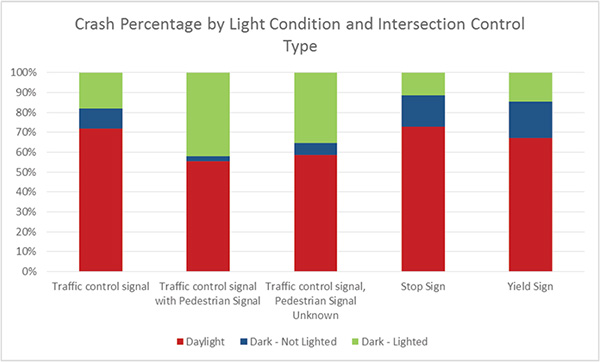
Figure 8. Crash percentage by lighting condition and intersection control type. (FARS Database, 2014)
| Traffic Control Device | Daylight | Dark—Not Lighted | Dark—Lighted |
|---|---|---|---|
| Traffic control signal | 275 | 39 | 70 |
| Traffic control signal with pedestrian signal | 446 | 20 | 344 |
| Traffic control signal, pedestrian signal unknown | 1,901 | 194 | 1,148 |
| Stop sign | 1,608 | 350 | 258 |
| Yield sign | 70 | 19 | 17 |
| TOTAL | 4,300 | 622 | 1,837 |
Fatalities by Intersection Type and Light Condition for Clear Conditions versus Rain
Figure 9 compares intersection type for weather conditions and shows an increase in the percentage of crashes at unlighted four-way intersections when rain is present. However, it is important to note that there are far fewer reported fatalities in rain conditions compared to clear conditions—5,002 fatalities compared to 372. The change in the percentage when lighting is added is interesting in that there appears to be a potential to reduce fatalities at intersections by adding lighting, in particular for T-intersections.
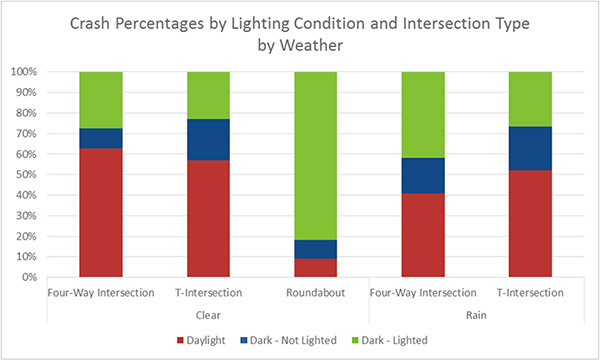
Figure 9. Crash percentages by lighting condition and intersection type by weather. (FARS Database, 2014)
Pedestrian and Bicyclist Safety Data
Pedestrian and Bicyclist Fatalities at Rural Intersection Types
Crash percentages (Figure 10) and total crashes (Figure 11) illustrate the major differences between main intersection types in rural zones. There are far fewer pedestrian- and bicyclist-related fatalities at intersections that are not either T-intersections or four-way intersections based solely on exposure since there is an overwhelmingly greater number of T- and four-way intersections. Interestingly, unlighted T-intersections are associated with more fatalities than other types for other lighting conditions, perhaps indicating a need for better understanding failure points at T-intersections and determining a need for lighting.
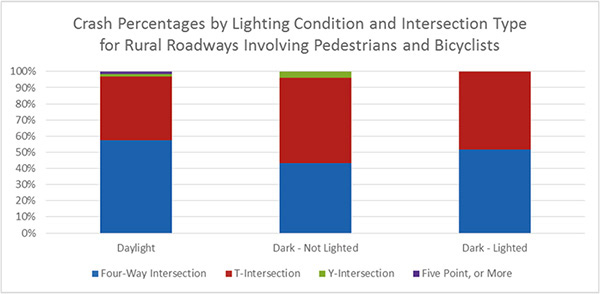
Figure 10. Crash percentages by lighting condition and intersection type for rural roadways involving pedestrians and bicyclists. (FARS Database, 2014)
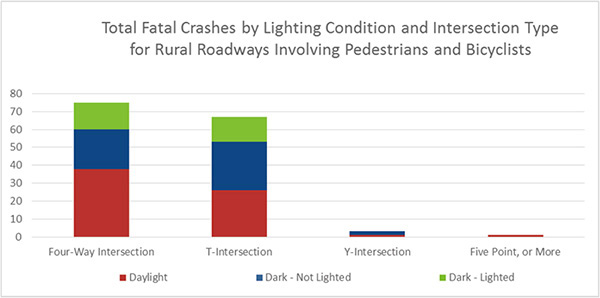
Figure 11. Total fatal crashes by lighting condition and intersection type for rural roadways involving
pedestrians and bicyclists. (FARS Database, 2014)
Pedestrian and Bicyclist Fatalities at Urban Intersection Types
Crash percentages (Figure 12) and total crashes (Figure 13) illustrate the major differences between main intersection types in urban zones. The trends are similar to those of rural roadways; however, the sheer volume of incidents is much greater for urban areas, as is expected. Dark, lighted roadways encounter more fatal crashes involving pedestrians and bicyclists due to the common roadway design of having lighting placed in areas where pedestrian and bicycle traffic is typical.
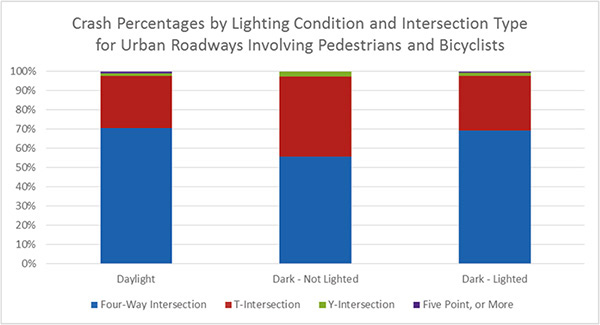
Figure 12. Crash percentages by lighting condition and intersection type for urban roadways involving pedestrians and bicyclists. (FARS Database, 2014)
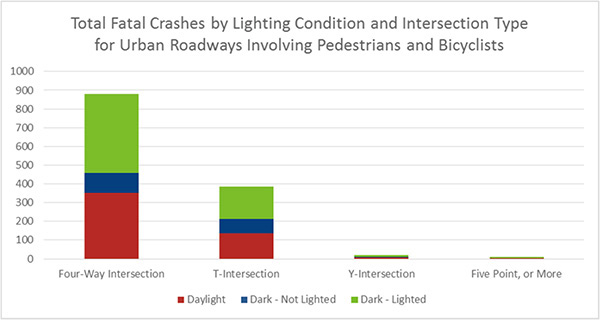
Figure 13. Total fatal crashes by lighting condition and intersection type for urban roadways involving pedestrians and bicyclists. (FARS Database, 2014)
Summary of Fatality Data Review
While the FARS database provides a rich source of information for the potential causes and remedies for fatal crashes, the limitations in the data—in that the actual exposure cannot be calculated—confine the ability to perform a complete analysis of the impact of visibility treatments on fatalities.
There are some initial trends in terms of the impact of lighting that can be seen when considering the fatalities. In terms of roadway departures, there seems to be an impact of lighting in bad weather. Similarly, in terms of the intersections, there is the potential to reduce fatalities at T intersections with the addition of lighting. There may be many other trends in the data, but they are likely hidden by the crash exposure rate.
One of the primary findings in the data is that there is a significant need to perform a complete and proper analysis of visibility treatments in terms of safety that accounts for exposure, retroreflectivity, and all roadway geometry impacts.
